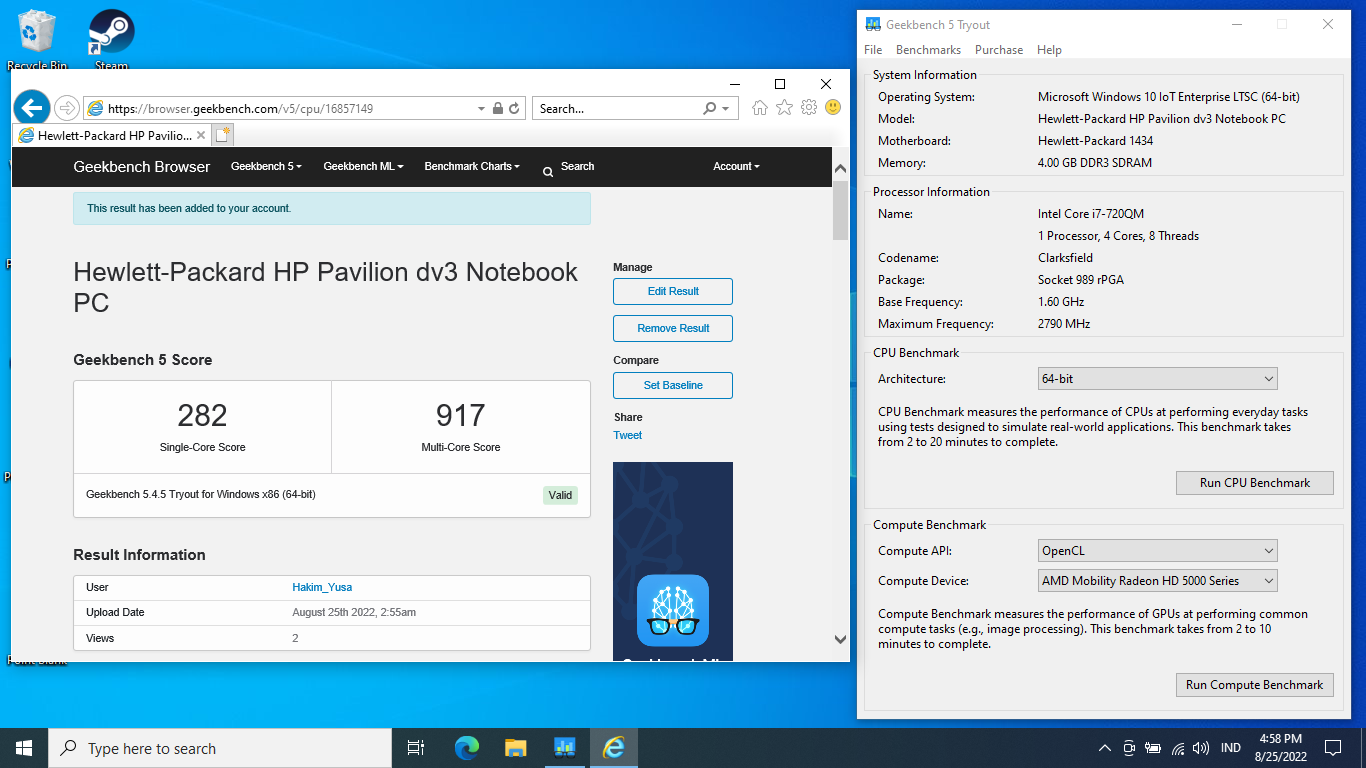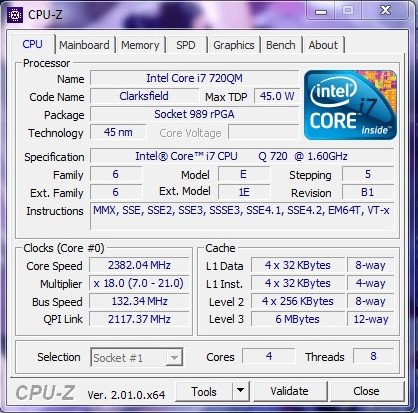Geekbench5 - Multi Core score 917 points with a i7-720QM
Thursday, 01 January 1970 07:00 | Update at null
Media Gallery
Screenshot

Device, Setup, etc



URL
https://hwbot.org/submission/5068123https://bit.ly/3L6lI1G
Information Detail
Hardware: Intel Core i7 720QM
Specs:CPUID : Intel(R) Core(TM) i7 CPU Q 720 @ 1.60GHz
Architecture : x86
Codename : Clarksfield
L3 Cache : 6MB
Clock : 1.60GHz - 2.80GHz
Core/Thread : 4/8
TDP : 45W
Technology : 45nm
Socket : PGA988
IGPU : -
See more specification...
Software: Geekbench5 - Multi Core
Score: 917 points
About: Geekbench5 - Multi CoreGeekbench 5 – Multi Core is one of the most popular benchmarks used to measure the overall multi-core computing performance of a processor. Developed by Primate Labs, Geekbench 5 offers a more modern approach than previous versions, with workloads that reflect the needs of applications and real-world scenarios in the era of multi-threaded computing.
In Multi Core mode, Geekbench 5 runs various types of heavy workloads such as machine learning, encryption, image processing, data compression, and physical rendering, all designed to utilize all cores and threads on the CPU. The resulting scores represent how efficiently the CPU divides the workload in parallel, and are highly relevant for users running heavy applications such as video rendering, CAD, virtualization, or other professional tasks.
This benchmark is highly useful for comparing modern processors with multiple cores. The higher the multi-core score, the better the processor is at handling multitasking and simultaneous workloads. Geekbench 5 also performs tests quickly yet accurately, making it ideal for users who want to evaluate performance quickly yet reliably.
Geekbench 5 supports various platforms including Windows, macOS, Linux, Android, and iOS, allowing users to compare performance across devices and operating systems in a consistent manner. This makes Geekbench 5 one of the most flexible benchmarking tools in the technology industry.
Overall, Geekbench 5 Multi Core is an effective and accurate testing tool for assessing CPU computational power in parallel work scenarios. It is suitable for both casual users who want to evaluate their PC's performance and professionals who need benchmark data to select the best processor for intensive computing needs.
The Intel Core i7-720QM, launched in Q3 2009, was one of the first mobile quad-core processors to feature Intel's Nehalem microarchitecture, specifically the Clarksfield variant. Targeted at high-performance laptops, such as gaming machines and mobile workstations, the i7-720QM brought 4 physical cores and 8 threads to the mobile platform, thanks to Hyper-Threading Technology providing a significant boost in multi-threaded workloads like video editing, 3D rendering, and other professional-grade applications. The processor runs at a base clock speed of 1.6 GHz, but it can dynamically increase up to 2.8 GHz using Intel Turbo Boost, depending on thermal headroom and power availability.
Manufactured using a 45nm process, the i7-720QM has a TDP of 45W, which is quite high by today's mobile CPU standards. This thermal demand necessitated more robust cooling solutions in laptops that featured the chip. Unlike modern CPUs, the i7-720QM does not come with integrated graphics, which means systems based on this processor require a dedicated GPU often from AMD or NVIDIA for graphics processing and display output. As such, it was typically paired with mid-to-high-end discrete graphics cards in its time, making it a solid choice for gaming and multimedia laptops in the late 2000s and early 2010s.
While the Core i7-720QM was a powerhouse during its release, its performance and efficiency are significantly outpaced by modern CPUs built on smaller nodes and with higher IPC (Instructions Per Clock). Nevertheless, legacy laptops using the i7-720QM can still be viable for basic computing tasks like web browsing, document editing, or watching videos especially if paired with an SSD upgrade and increased RAM. Users running Windows 10 on such systems may experience some limitations, but with proper optimization and lightweight software, the CPU can still deliver a usable experience in non-demanding environments.
Hardware Detail:
Device: HP Pavilion dv3-4054TX
RAM: 4GB DDR3 Single Channel
OS: Windows 7, Windows 10
* Not Avaiable
